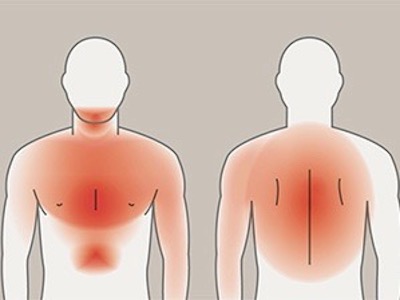Chest pain has different causes, but what they all have in common is that they frighten those affected. Although up to 90% of the symptoms can be classified as harmless in an initial assessment, it is still important for those affected to act quickly. Especially in life-threatening situations, every minute is crucial.
Interview with Prof. Dr. med. Christophe Wyss
Chest pain is a common problem. In the Swiss population as a whole, an average of 1 to 2 percent of all people surveyed report having experienced chest pain in the last four weeks (women slightly more frequently than men).
It is estimated that 20 to 40 percent of the total population will experience chest pain at least once in their lives. Such complaints cause anxiety for those affected and are the reason for 4 to 10 percent of all visits to the family doctor.

Prof. Dr. med. Christophe Wyss – Interventional Cardiology – HerzKlinik Hirslanden
From harmless to life-threatening
The causes of chest pain are extremely varied, can affect different organ systems in the chest and – depending on the cause – can be absolutely harmless or acutely life-threatening. Fortunately, with targeted questioning, clinical examination and selected additional examinations such as an electrocardiogram, blood test or imaging, around 90 percent of all situations can be classified as harmless without the need for further clarification in the family doctor’s practice or emergency ward. Only rarely are complex instrumental examinations required (e.g. computer tomography, ultrasound examination, angiography), which are only available in emergency wards or hospitals. The primary aim is to rule out dangerous circumstances through targeted risk stratification.
Dangerous cardiovascular conditions include myocardial infarction, aortic dissection, hypertensive crisis and pulmonary embolism. In these cases, specific treatment must be initiated without delay, which usually requires rapid hospitalization or referral to a specialist center.
Reaction time influences the course
In many acute clinical pictures, the intravenous use of medication to regulate blood pressure (in the case of derailed blood pressure) or to thin the blood (in the case of a pulmonary embolism or suspected thrombosis) should be considered. In the case of a heart attack, the blocked coronary vessel must be reopened as quickly as possible with a catheter intervention, and in the case of aortic dissection, emergency cardiac surgery is usually required to replace the torn aorta.
All these measures should be initiated while the patient is on standby for resuscitation – defibrillator ready for use, competent personnel on site for resuscitation/cardiac massage – as circulatory arrest can occur at any time. A well-functioning network of primary care providers, specialists, emergency services and hospitals is essential for efficient patient care.
Any delay in treatment can have fatal consequences for the further course of the disease: In the case of aortic dissection, for example, a quarter of all patients die within the first 24 hours after the event (1 percent mortality rate per hour!); in the case of a heart attack, a delay in opening the affected coronary artery results in an irretrievable loss of valuable heart muscle tissue, which in turn leads to cardiac insufficiency.
Warning signs of heart attack/angina pectoris
- Discomfort, pain, tightness, tightness or burning, usually behind the breastbone
- Sometimes radiating over the entire chest, occasionally into the shoulders, arms, lower jaw, neck, back or upper abdomen
- The symptoms typically occur during physical exertion, excitement or after eating. The symptoms pass or subside within 2 to 15 minutes.
Interpreting warning signals correctly
Unfortunately, there are always delays because the patient does not recognize the alarm symptoms of a heart attack in time or does not consider them to be serious. Typical warning signs or harbingers of a heart attack are Discomfort and/or pain such as tightness, clamping or burning, usually behind the breastbone. Sometimes the pain radiates to the entire chest, especially to the left, occasionally to both shoulders, the arms, the neck up to the jaw, the back or upper abdomen. Typically, these symptoms occur during physical exertion, excitement, after a hearty meal or in cold weather. If these symptoms last longer than 2 to 15 minutes or are even persistent, an acute heart attack is suspected and immediate medical clarification or intervention is required.
These symptoms are perceived differently depending on gender: Women are more likely to have atypical symptoms such as acute shortness of breath, nausea or weakness. Symptom misrecognition with subsequent delay in treatment is particularly common in older and single patients with pain onset at home, at night or in the morning, and atypical symptoms. Interestingly, married people have the shortest alarm times.
Attentive awareness of physical symptoms, immediate, targeted further medical clarification and individual risk stratification lead to the best possible clarification and treatment of chest pain. Fortunately, only a few diseases with chest pain are dangerous, but these should not be missed!
(Text source: patient magazine “Mittelpunkt”)



